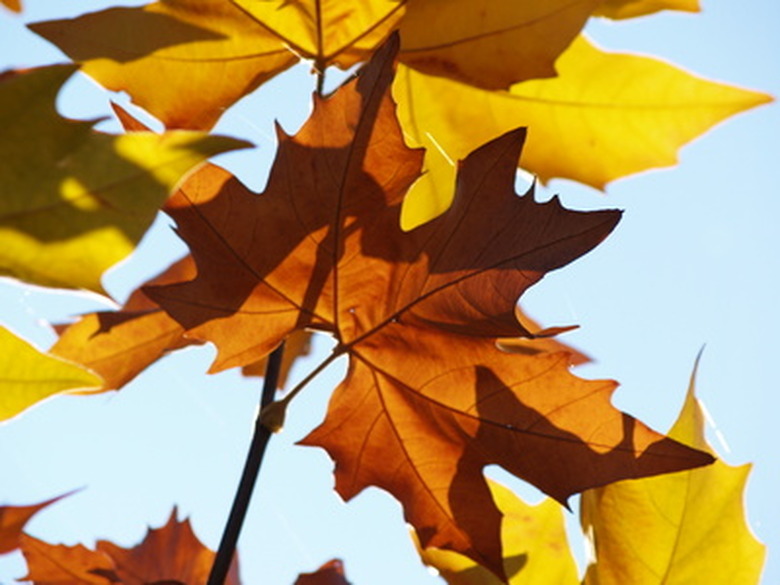American Sycamore Vs. Tulip Poplar
Among the tallest deciduous trees native to the forests of the eastern United States, both the American sycamore (Platanus occidentalis) and the tulip poplar (Liriodendron tulipifera) are prized by gardeners as stately shade trees. They do possess different features and growth tolerances that can make the choice between their selection for use in a landscape easier. One commonality is that they are grown across the same USDA winter hardiness zones: 4 through 9.
Among the tallest deciduous trees native to the forests of the eastern United States, both the American sycamore (Platanus occidentalis) and the tulip poplar (Liriodendron tulipifera) are prized by gardeners as stately shade trees. They do possess different features and growth tolerances that can make the choice between their selection for use in a landscape easier. One commonality is that they are grown across the same USDA winter hardiness zones: 4 through 9.
Native Range
Both the sycamore and tulip poplar hail from roughly the same natural distribution across the eastern United States. They generally range from the shores of the southern Great Lakes eastward to Maine and south to northernmost Florida and westward to the Mississippi River Valley. A key difference in the native ranges is that the western edge for the tulip poplar is a line from roughly Chicago to Memphis, Tenn., and Baton Rouge, La., while that of the sycamore extends from Des Moines, Iowa to Oklahoma City, Okla., and Austin, Texas.
Size
The sycamore tree typically grows 75 to 100 feet tall with width of 65 to 90 feet and the tulip poplar reach a mature height 70 to 120 feet tall with width of only 35 to 50 feet wide. Therefore, a more spacious landscape is needed to accommodate the more broadly-reaching canopy branches of a sycamore tree. According to the U.S. Forest Service, the sycamore's trunk grows to a larger diameter than any other North American hardwood tree.
- Among the tallest deciduous trees native to the forests of the eastern United States, both the American sycamore (Platanus occidentalis) and the tulip poplar (Liriodendron tulipifera) are prized by gardeners as stately shade trees.
- According to the U.S. Forest Service, the sycamore's trunk grows to a larger diameter than any other North American hardwood tree.
Growth Characteristics
The American sycamore is a fast-growing tree, with a singular trunk any many crooked, muscular branches that spread upward and outward to form a rather round canopy. The U.S. Forest Service regards it as a "wind steadfast" tree because of its extensive, deep root system. In contrast, the tulip poplar is distinctively pyramid-like when young with dense branching and then with age becomes a tall tree with a straight trunk and high branches. Overall, its canopy is upright oval but with downward curving, irregular branches.
Ornamental Features
Once you see the bark of an American sycamore, you'll likely never forget it. In winter the tree's structure is ghostly white to beige. Upon closer inspection of the trunk you will see a flaking, mottled bark in colors of olive-green, tan, brown and gray-white. Its leaves are maple-like in shape with wide, pointed lobes that turn tan and yellow in autumn. Sycamore fruit are round balls with tiny prickles.
- The American sycamore is a fast-growing tree, with a singular trunk any many crooked, muscular branches that spread upward and outward to form a rather round canopy.
- In contrast, the tulip poplar is distinctively pyramid-like when young with dense branching and then with age becomes a tall tree with a straight trunk and high branches.
Tulip tree bark is medium and light gray and vertically furrowed–attractive but subtly so. The leaves are broad and oval but have four spreading points that make it resemble a child's drawing of a tulip flower. In late spring the tulip-like yellow-green and orange flowers are found on branch tips high in the canopy. In autumn the leaves turn warm golden yellow. The fruit of the tulip poplar look like cones that are golden brown and persist across winter.
Tolerances
Both the sycamore and tulip poplar grow best in deep, fertile soils that are moist but well-draining. The tulip poplar is much more sensitive to drought than the sycamore. Avoid planting tulip poplars in landscapes that are hot and dry. The sycamore demonstrates more tolerance of heat and drought conditions, as well as salty soils such as those found near beaches or in urban areas.
- Tulip tree bark is medium and light gray and vertically furrowed–attractive but subtly so.
- The fruit of the tulip poplar look like cones that are golden brown and persist across winter.
References
- "Dirr's Hardy Trees and Shrubs"; Michael A. Dirr; 1997
- U.S. Forest Service: Liriodendron tulipifera
- U.S. Forest Service: Platanus occidentalis
